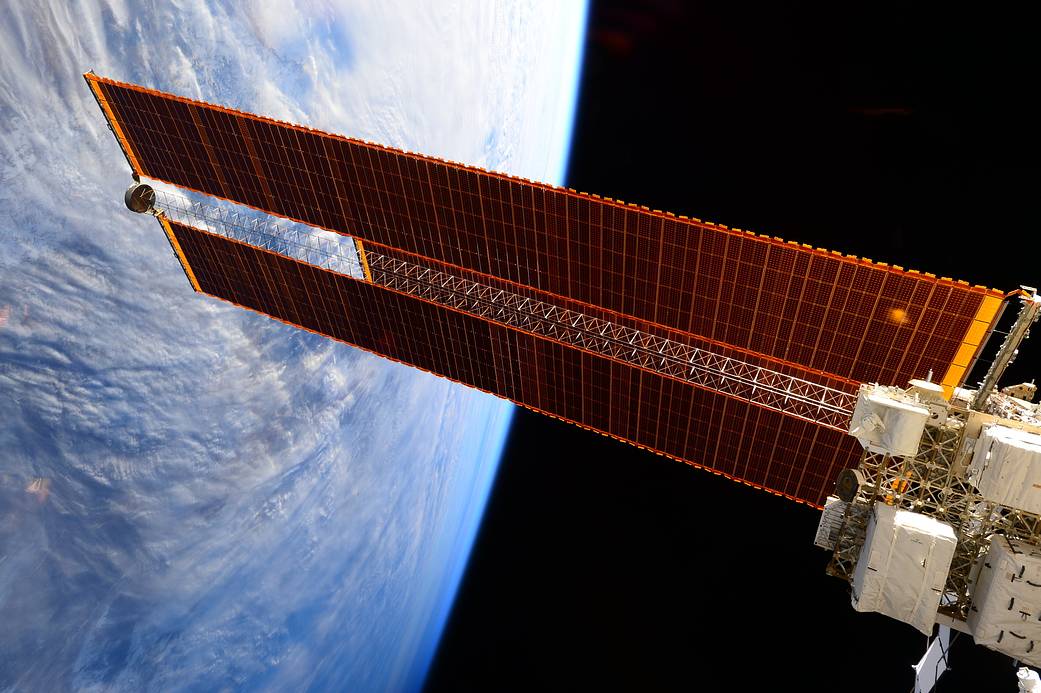
How do you get electricity 220 miles above Earth?
That was the problem scientists faced when planning on how to keep the International Space Station (ISS) functioning as it travels at 17,895 miles/hour around the planet experiencing a sunrise every 90 minutes (16 during a 24-hour period).
They found the answer in solar cells that convert light to electricity. NASA and its partners mounted solar arrays on a “blanket” that can be folded like an accordion while gimbals are used to rotate them so they continually face the sun.
Today, the ISS features eight solar arrays measuring 112 ft long x 39 ft wide. They generate between 84-120 kW of electricity, more power than the station needs to keep its systems and experiments going. “When the station is in sunlight, about 60 percent of the electricity that the solar arrays generate is used to charge the station's batteries. At times, some or all of the solar arrays are in the shadow of Earth or the shadow of part of the station. This means that those arrays are not collecting sunlight. The batteries power the station when it is not in the sun,” NASA explains.
Space solar power harvesting
Allaboutcircuits.com notes that space solar power is unlimited, available 24 hours a day, and expected to last for another four billion years. This is because sunlight in space is constant, unaffected by day/night cycles and weather conditions.
This is leading some scientists to ponder the possibility in the near future of harvesting solar power in space.
“A typical setup will involve building a solar-based power station in space and a ground receiver on the Earth’s surface. The solar panels will generate the electrical energy, convert it into microwaves or a laser beam, and wirelessly transmit the energy to a ground receiver. The ground receiver will then convert the received energy into electricity,” explains www.allaboutcircuits.com.
Another way is by using solar power satellites equipped with solar panels and large mirrors that will direct sunlight to the panels.
The U.S. already has plans for this. And so does its rival, China. The Asian superpower plans to launch small-to medium -sized solar power projects in the stratosphere to generate electricity between 2021-2025, followed by a space-based solar power station that generates at least a megawatt of electricity in 2030, and a commercial-scale solar power plant in space by 2050, according to CNBC.
Light not heat
The fact that solar panels on space can generate electricity is based on a simple reason: they need light, not heat.
As explained in Scientific American, when sunlight hits the solar cells made out of silicon, it produces an electrical current. “Silicon can do this because the electrons in the crystal get up and move when exposed to light instead of just jiggling in place to make heat.”
While solar panels will produce the maximum electricity when facing the sun directly, even partial or indirect sunlight. That’s why even homes located in cold, cloudy locales can generate electricity with a domestic solar power system.
Will Woll, who identifies himself as a “proud owner of a PV solar system,” found out about this recently.
“Since we installed our system in mid-February, we have 31.5 kWh generated per day. On a bright and sunny day (with very few clouds) we have generated over 50 kWh, but on a day like last Sunday and Monday (5/12 & 5/13) we had two straight days of thick overcast and very steady rain. On those days, our panels STILL generated 6.5 and 8.2 kWh (our average daily USAGE of electricity is around 20 kWh for this time of year). This means on days where the sun never even peaked through the gloom, our solar panels still generated at least 1/3 an average days worth of electricity,” he noted in an online message board dedicated to solar power.
In fact, while temperature won’t change how much energy a solar panel absorbs from the sun, it actually can change how much of that energy is converted into electricity. If a solar panel is extremely hot or extremely cold, its efficiency does drop.
Solar panel efficiency drops by around 0.05 percent for every degree Celsius increase in temperature. On the other hand, efficiency increases by 0.05 percent for every degree Celsius decrease in temperature.
However, you often don’t notice this drop or increase because of light. In summer, when hotter weather slightly decreases the solar panels’ efficiency, the difference is made up by longer hours of sunlight. In winter happens the reverse: slightly more efficiency but fewer hours of sun.
The perfect day for solar panels are cold, sunny, and windy. On these days they get plenty of sunshine, they keep cool and the wind sweeps away the heat generated within the module itself.
The bottom line is that no matter where you live, installing solar panels in your property will produce savings in your electric bill.
HahaSmart Blog - More Solar Tips and Guide
HahaSmart News - Stay Informed
Your Solar Incentives - See Credits and Incentives in Your Area
Check Your Home's Solar Price - See How Much You Save
Register Now - Unlock The Lowest Solar Prices in Your Area


Input your address to see if it is solar friendly and how much you can save with solar.
Great. Your address is perfect for solar. Solar incentive is still available. Select monthly utility cost and calculate the size of solar system you will need now.
| kw System size | years Payback period | Lifetime savings |
No money down, 100% finance is available.
|
|
Sign up to learn more about home solar panel costs, see quote right away |
Comments